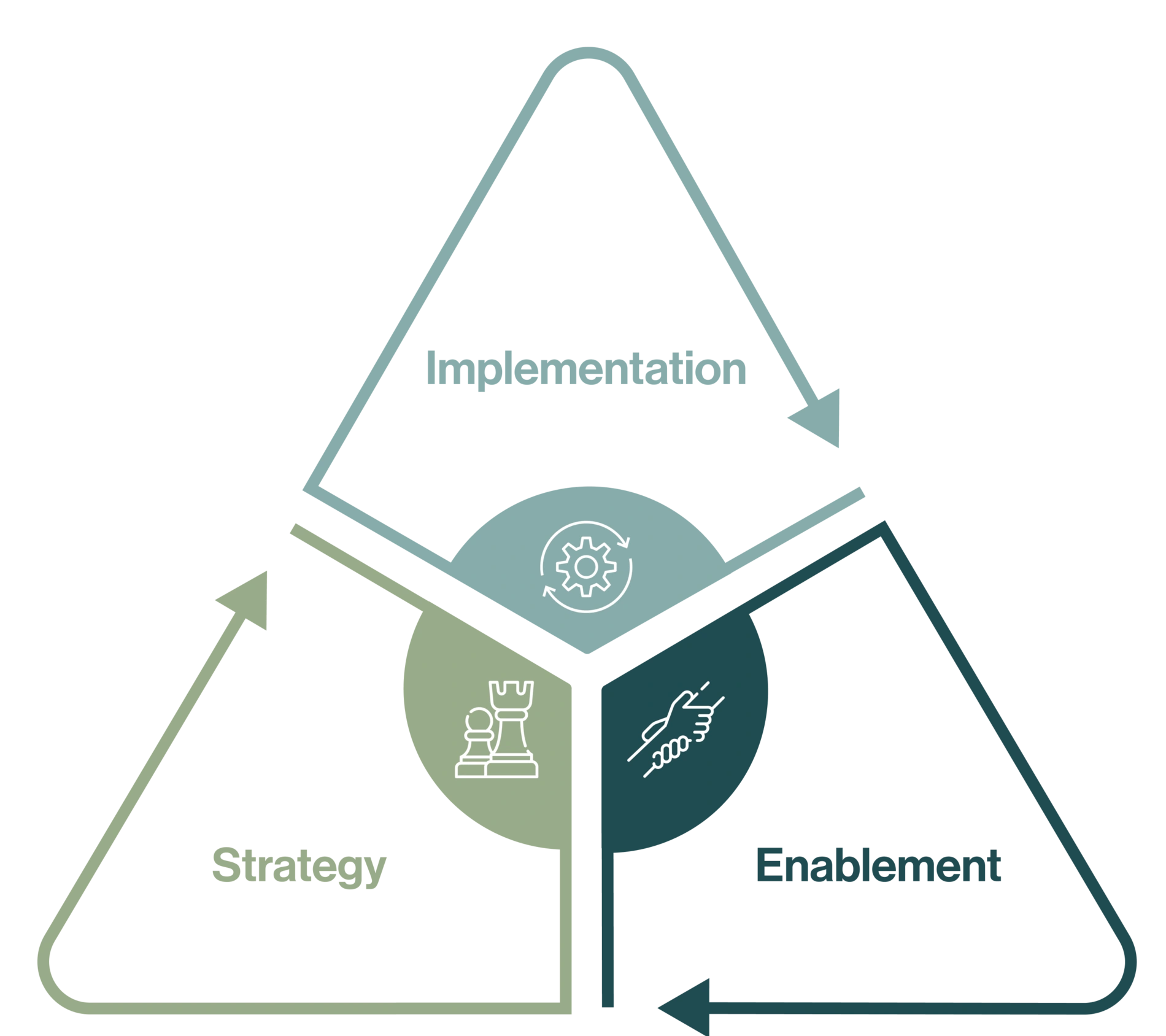
Digital Life Insurance
SolidaVita

Chance
To remain competitive and unlock new growth opportunities, it’s essential for companies to have a clear innovation strategy closely tied to their business goals. This strategy should enable the evolution of existing structures while fostering new ideas. Innovative companies adeptly balance managing their core business with developing future-oriented solutions. Leveraging our expertise in innovation management, we assist clients in navigating the dynamic between “Running the Business” and “Changing the Business,” guiding your organization toward sustainable growth through innovation—from strategy development to execution.
Innovation involves creating and successfully implementing advanced products, services, processes, and business models. We categorize innovation into three horizons:
Horizon 1 focuses on optimizing and enhancing the existing business model to strengthen the current market position, aiming for value growth over the next 1–2 years.
Horizon 2 centers on innovations extending beyond today’s core offerings, such as new business areas and technologies, to secure medium-term growth (2–5 years) and value creation.
Horizon 3 concentrates on radical, transformative ideas and business models that can realign the company long-term and potentially tap into disruptive markets.
A targeted innovation strategy aligns the three horizons with the corporate strategy, enabling value creation and growth across all timeframes.
However, many companies struggle to implement innovations successfully. Key factors to consider when developing a clear approach to innovation include: While innovation frameworks often emphasize Horizon 3 (H3) innovations, market conditions and rising financing costs often necessitate a focus on core business areas (H1 and H2). The result? Innovation efforts become isolated from day-to-day operations, and creative ideas—hindered by full project portfolios in operational business—are not effectively translated into market-ready solutions. To address this, a clear strategy with a strategic prioritization of innovation horizons is essential. Additionally, unambiguous internal communication, the right talent, organizational flexibility, and sufficient resources are critical to fostering innovation that meets both current and future business needs.
We take a holistic approach, working closely with our clients to strengthen innovation systems and successfully implement innovation projects. To overcome the challenges of innovation effectively, an approach that is strategically aligned, implementation-focused, and empowering is essential. These elements are critical for successful innovation across industries and are at the core of our innovation methodology.

To acquire new customers, companies must have a clear understanding of their various customer segments, offer a well-aligned product portfolio with optimal product-market fit, and leverage the right mix of sales channels. The sales process should be designed for efficiency, from the first marketing interaction to deal closure. This requires breaking down silos between marketing, sales, customer service, and product development, and implementing an integrated strategy where all departments work closely together.
What role should innovation play for the company, and what ambitions do we aim to achieve (First Mover vs. Fast Follower)?
Which market and technology fields, as well as markets and technologies, hold significant potential for us?
In which horizons (see diagram) do we want to innovate, and how do we plan to structure our innovation portfolio?
Which vehicles will be utilized for each horizon, such as Innovation Labs with a gate process, Venture Building, M&A, Venture Capital, or Venture Clienting?
How do we structure our governance and processes according to each innovation and investment vehicle?
What budgets and resources are assigned to each vehicle?
Establishing new business units close to the core business to drive sustainable growth.
To acquire new customers, companies must clearly understand their customer segments, offer a well-matched product portfolio with optimal product-market fit, and act decisively to create value in a world of increasingly shorter product and business model lifecycles. Speed and decisiveness are essential. While a clear strategy forms the foundation, it only comes to life through effective implementation. Following the principle “Think Big, Start Small,” innovation is about taking action and implementing ideas. Depending on the strategy and phase, there is a wide range of action-oriented measures to drive progress effectively:
What role should innovation play for the company, and what ambitions do we pursue (First Mover vs. Fast Follower)?
Systematic and Regular Identification and Classification of Trends and Technological Developments to Stay Ahead of the Curve.
Targeted Networking with Startups to Integrate Innovative Solutions Directly into the Value Chain – Quickly, Efficiently, and Effectively.
Development of Ideas from the Initial Sketch to a Market-Ready Prototype Through Fast and Focused Innovation Sprints – Efficiently and with Maximum Impact.
Establishing Agile Ventures Outside the Company to Strategically Foster Disruptive Innovations Without Slowing Down Day-to-Day Operations.
Development of Digital Products That Inspire, Create Innovative Customer Experiences, and Lead the Company into the Digital Future.
Successful innovation increasingly requires the ability to continuously build new innovation competencies—or bring new skills and expertise into the company from the outside. We support organizations in identifying the critical capabilities and choosing the best approach to acquire them, whether through corporate venturing, partnerships, acquisitions, or internal development. In this process, the establishment and continuous nurturing of an innovation culture through various formats, as well as human-centered change management, play a particularly important role.
Solida has maintained a highly stable and sustainable business model for many years, characterized by operational excellence. To future-proof the business model and stay ahead of the curve, we were tasked with developing a continuous trend monitoring system. New digital business models, products, services, and trends are systematically screened and evaluated.
As a leading cooperative bank in Switzerland with decentralized structures, Raiffeisen faces the ongoing challenge of fostering innovation and activating the innovative potential of its banks. To meet these demands, a comprehensive and sustainable innovation process was necessary.
Despite its world-class genetics and medical team, Arcensus had gaps in marketing and digital product development. Our primary tasks were to build a product team and a medical portal for customers and physicians, as well as to establish an international marketing and sales strategy, including brand development and a partner network, to make “Whole-Genome Sequencing” easily and affordably accessible to everyone.
As part of Solida’s digitalization strategy, a modern web presence and the development of digital premium calculators were to be advanced to facilitate the online conclusion or application for insurance policies. The challenge was to integrate the highly diverse and complex insurance products into an innovative and digital tool. The goal was to create a product that is perfectly tailored to the needs and requirements of the target audience. This required comprehensive coverage of the entire value chain—from the conception of the business model to detailed product planning and technical implementation.
How We Help